Workshop 2: Being Human Starting with fungus (lol)
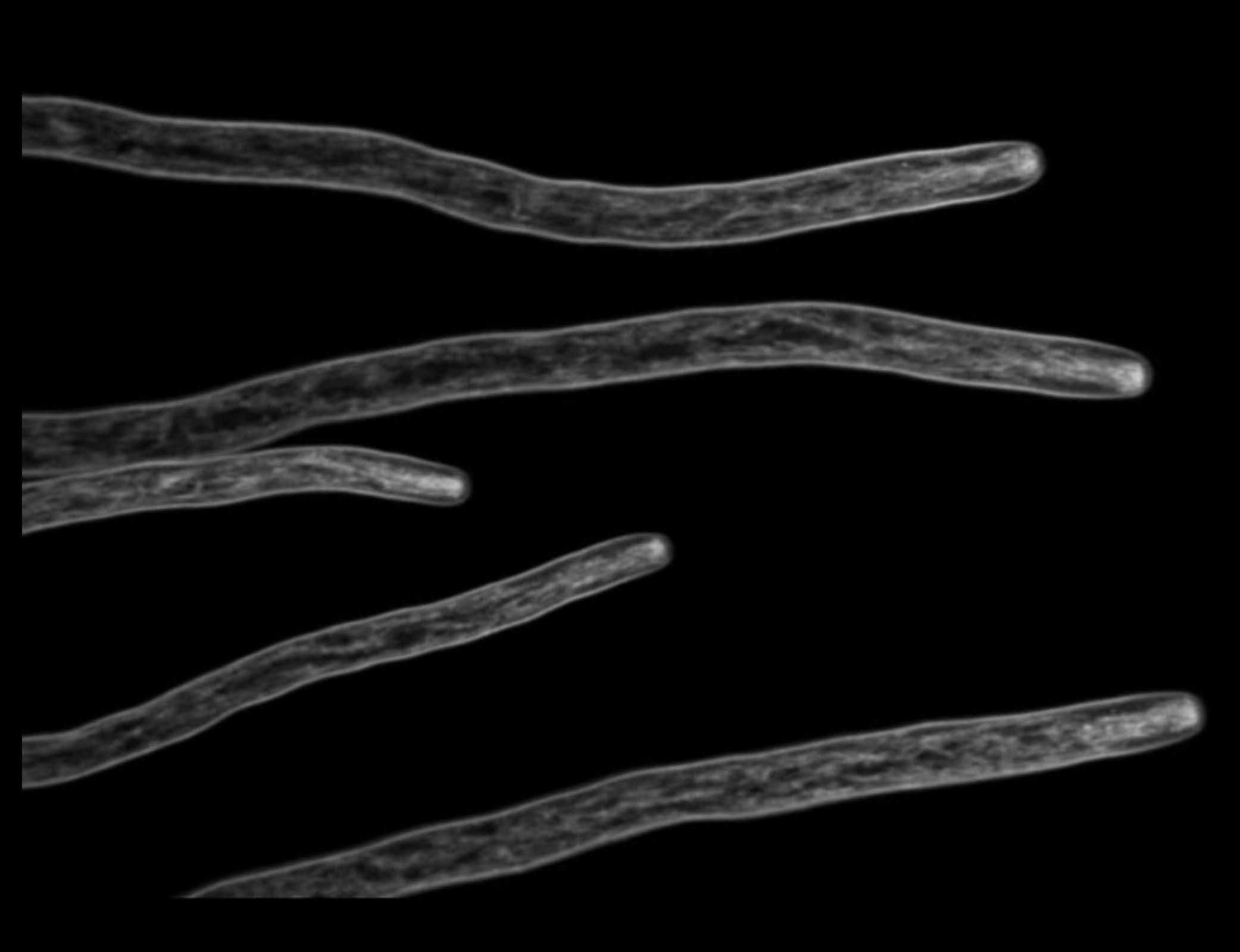
Stream of consciousness Writing
Stream of consciousness writing refers to a narrative technique where the thoughts and emotions of a narrator or character are written out as they happen.
Because it’s mimicking the non-linear way our brains work, stream-of-consciousness narration includes a lot of free association, looping repetitions, sensory observations, and strange (or even nonexistent) punctuation and syntax. It’s meant to feel like you have dipped into the stream of the character’s consciousness—or like you’re a fly on the wall of their mind.
https://www.youtube.com/watch?v=i9T727tz7FA&t=60s
Section 1: intimate associations
“Some fungi have learned to live in intimate associations with plants and giv en enough time, most plants enter into associations with fungi.” Most plants are full of tiny fungi that are invisible to the naked eye.
Fungi that have evolved to live inside roots and wrapped around them (ectomycorrhizas) “are not limited to one collaboration; the fungus forms a network across plants. In a forest, fungi connect not just trees of the same species, but often many species. If you cover a tree in a forest, depriving its leaves of light and thus food, its mycorrhizal associates may feed it from the carbohydrates of other trees in the network…” (Tsing, A. 139, 2015)
Fungus, plural fungi, any of about 144,000 known species of organisms of the kingdom Fungi, which includes the yeasts, rusts, smuts, mildews, molds, and mushrooms (from britannica.com)
Mycorrhiza: the symbiotic, or mutually beneficial, relationship between a fungus and the roots of a plant
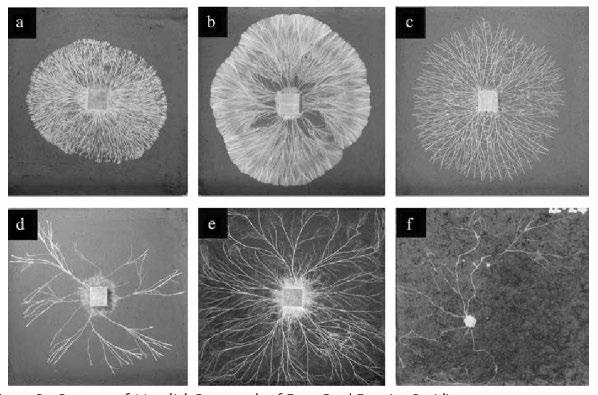
https://www.semanticscholar.org/paper/13-Network-Organisation-of-Myceli al-Fungi-Fricker-Boddy/bedac294f2847fb4e71afd7a66d0acf34b3ba529
Mycelial networks transform individuals into the collective we call forest; “Neither the fungus nor the plant can flourish without the activity of the other” (Tsing, A. 2015, 138).
Mushrooms - source unknown

Fungi have made life as we know it possible, from the food we eat, to the air we breathe. We wouldn’t exist without them.
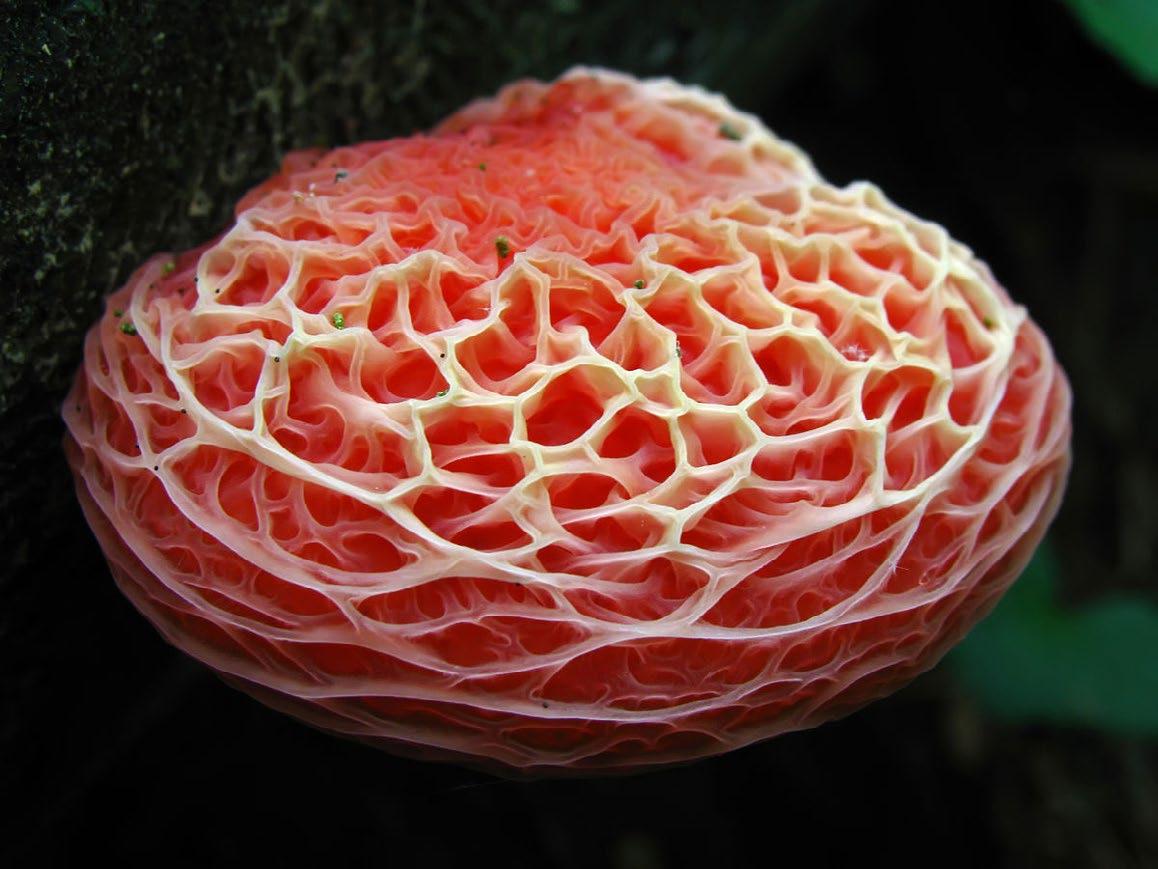
“The reason there are plants growing on dry land (rather than just in water [where life began]) is that over the course of earth’s history fungi have digested rocks, making nutrients available for plants. Fungi (together with bacteria) made the soil in which plants grow. Fungi […] are world builders, shaping environments for themselves and others” (Tsing, A. 2015, 139).
Why has the world building work of fungi received so little appreciation? Partly, this is because people can’t venture underground to see the amazing architecture of the underground city. But it is also because until quite recently many peopleperhaps especially scientists - imagined life as a matter of species by species reproduction. [i.e entirely reliant on themselves, not interacting or being changed or formed or affected by other species]. The most important interspecies interactions, in this worldview, were predator-prey relations in which interaction meant wiping each other out. Mutualistic relations were interesting anomalies, but not really necessary to understand life. Life emerged from the self-replication of each species, which faced evolutionary and environmental challenges on its own. No species needed another for its continuing vitality; it organized itself (Tsing, A. 2015, 139).
This highlights how important it is to be imaginative in our thinking, to make visible what we cannot at first see
Section 2: world builders
Rhodotus is a genus in the fungus family Physalacriaceae - Wikipedia
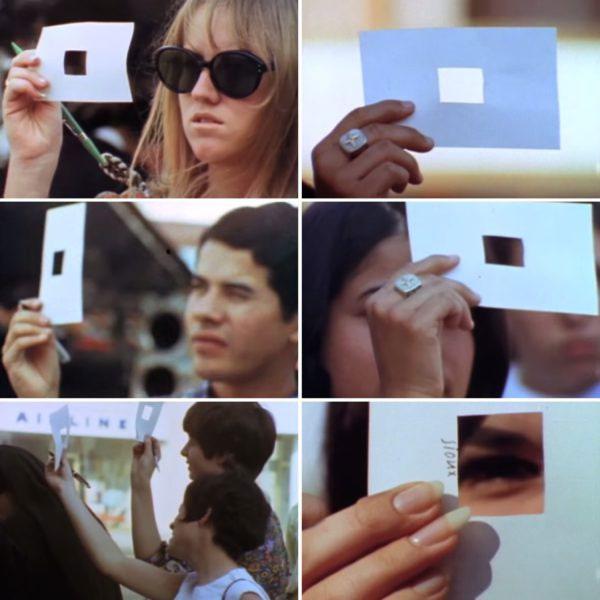
Make a Finder / Become a Microscope
The Finders are described in the book based on her teachings, Learning By Heart: [The finder] is a device, which does the same things as the camera lens or viewfinder. It helps us take things out of context, allows us to see for the sake of seeing, and enhances our quick-looking and decision-making skills.
Learning by Heart: Teachings to Free the Creative Spirit by Corita Kent. Pg 27
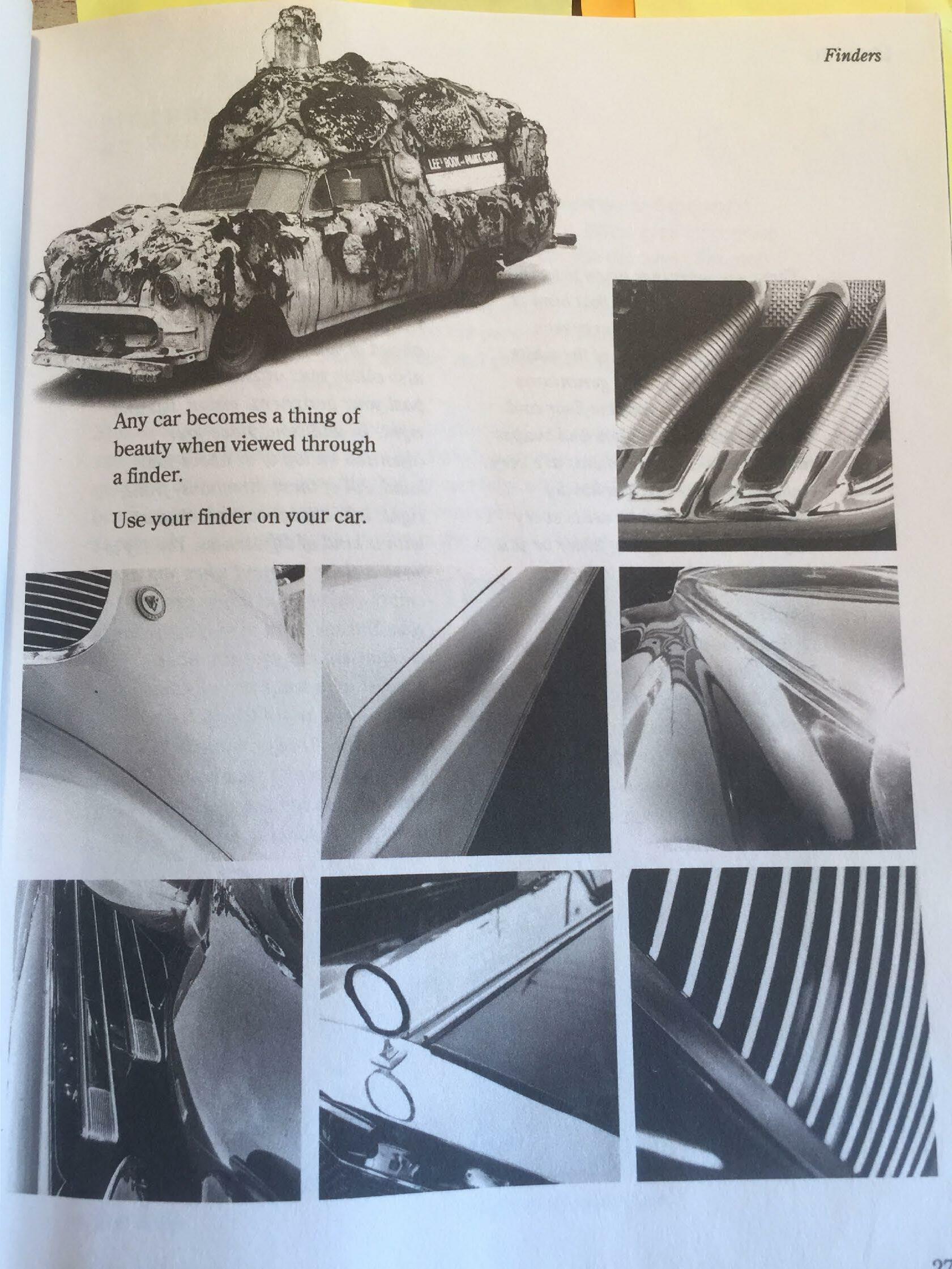
What you need:
A4 pieces of paper ScissorsDraw 9 rectangles on your a4 paper 9 x 20 secs drawing exercises (3 min total)
Move your finder to a different part of the screen each time, can attach it with a small bit of tape, or hold with your hand while you draw
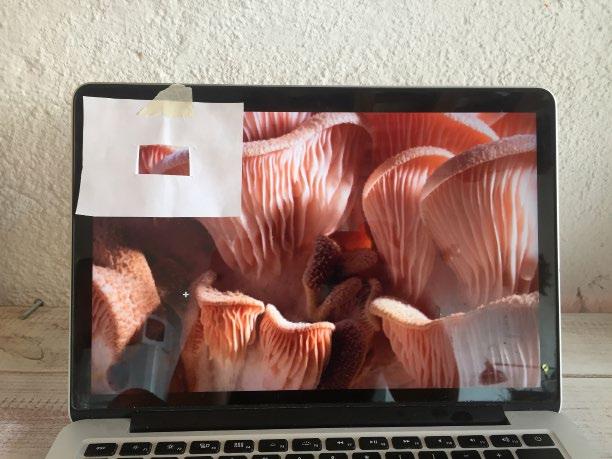
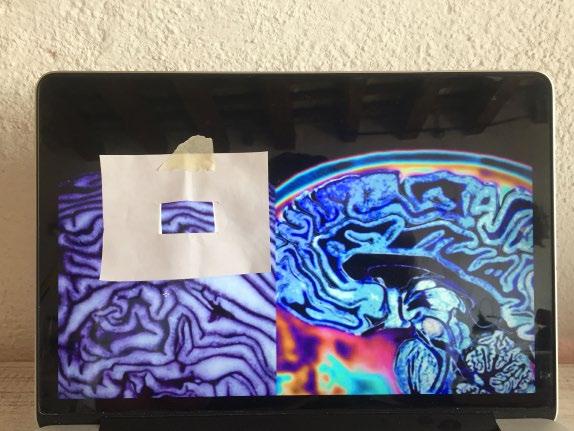
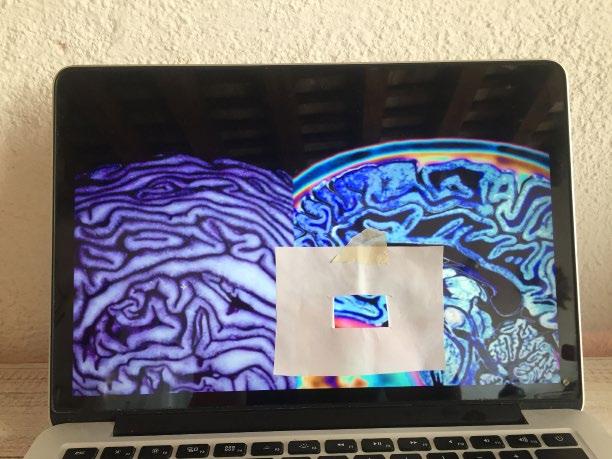
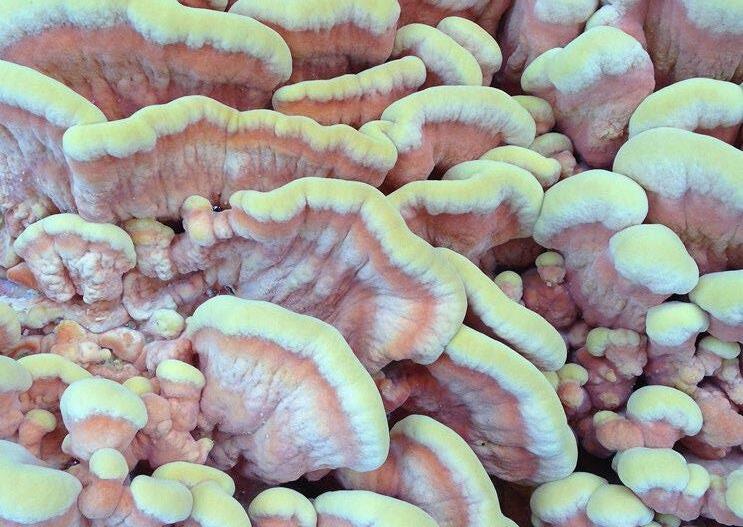
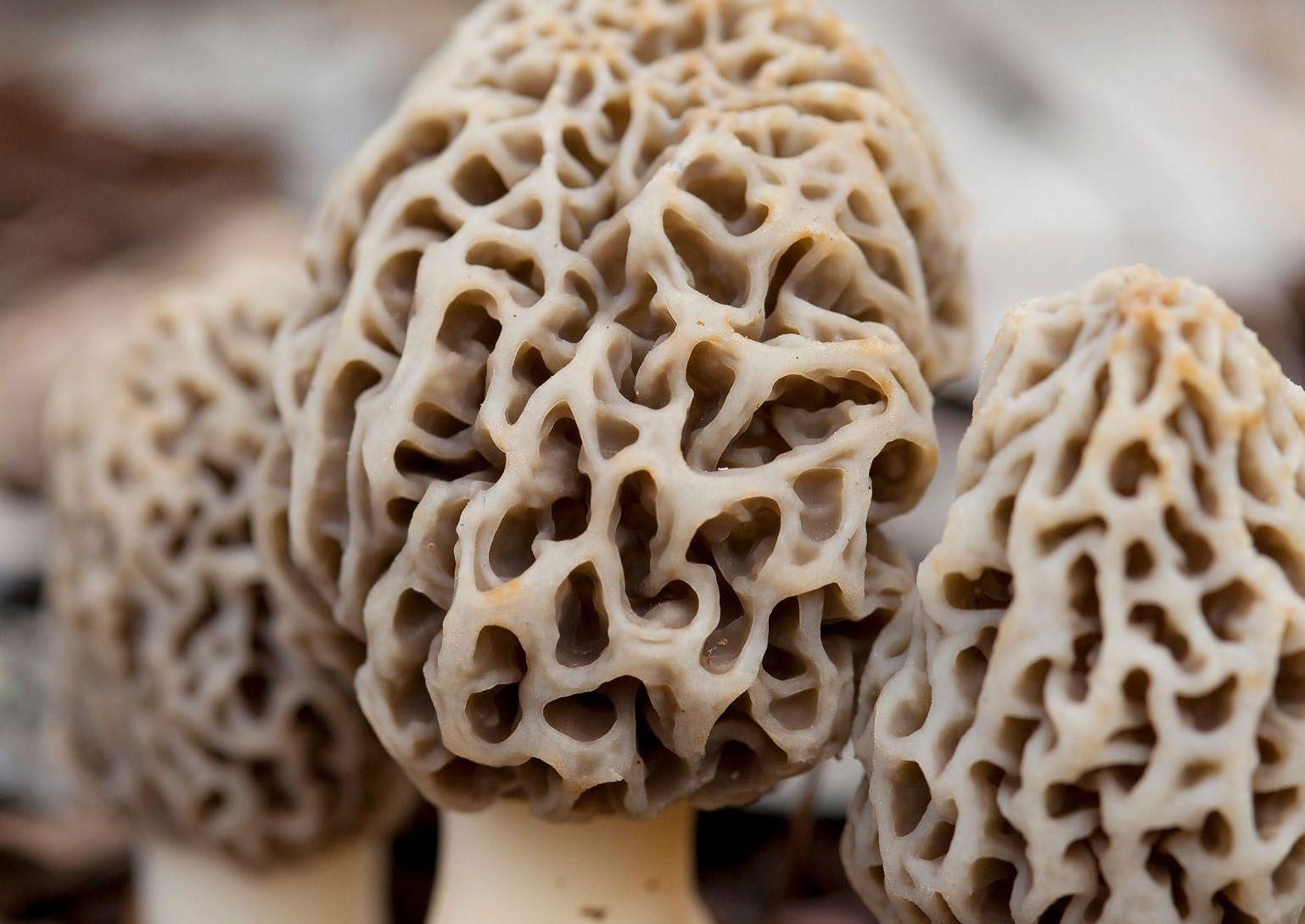
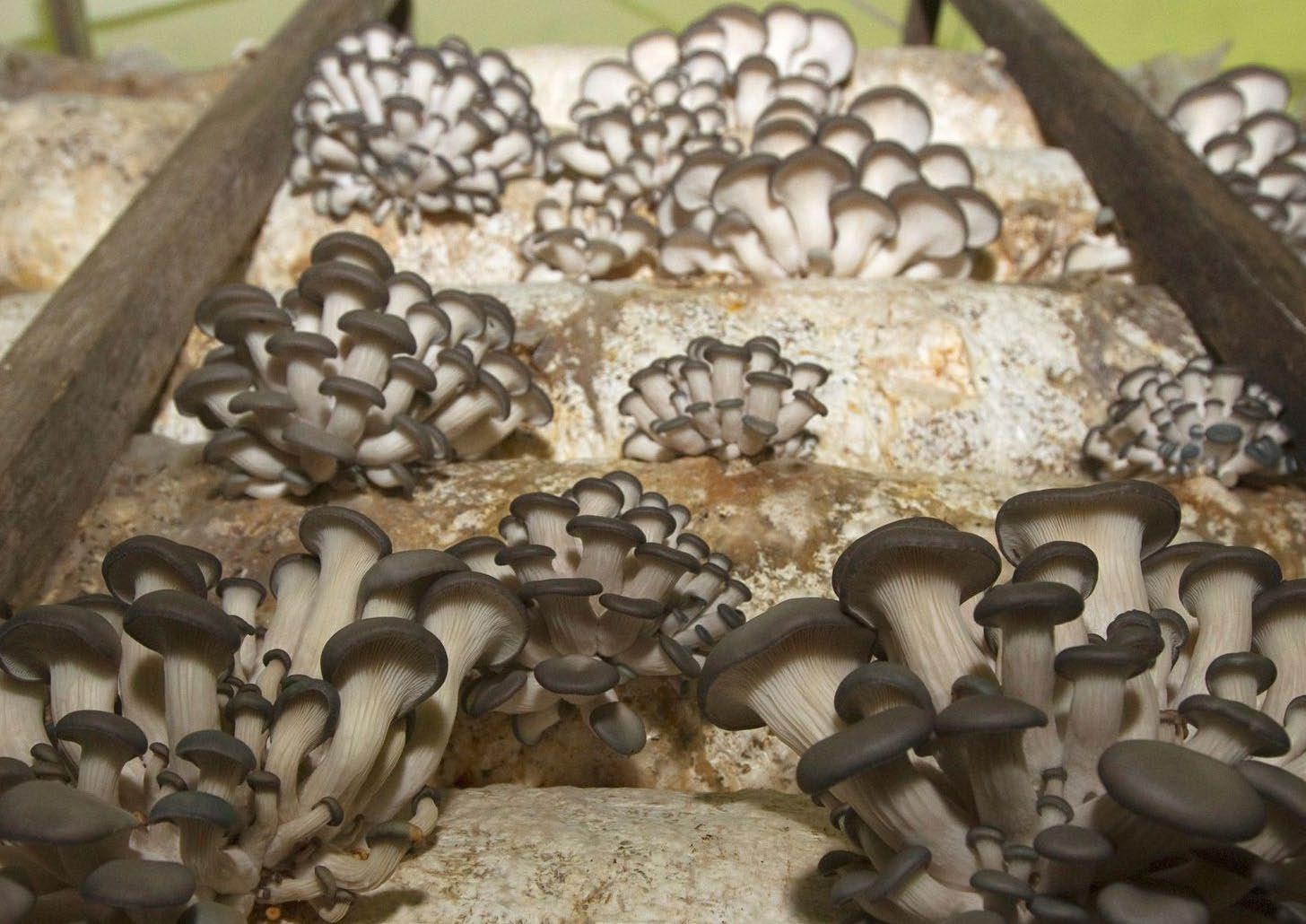
Particular ideas of what it means to be human have dominated every aspect of our time. Politics, science, culture, economics and consumerism all revolve, or did until recently, around the idea of self-contained, self-reliant and self-serving ‘individuals’. Ideas like survival of the fittest have created a politics of exclusion and lead to genocidal policies, they’ve created the false impression that humans, and particular types of humans, are at the apex of the pyramid.
But we live only by the grace of fungi and other microorganisms. Not only would there be no food for us to eat, or oxygen for us to breathe, we’d be surrounded by dead bodies that can never decompose. More than 90% of life on earth consists of microorganisms (Mann, C. 22, 2019)*. More than 90% of life is invisible to us. Microorganisms were here millions of years before us, they shaped the world we live in, and since they thrive everywhere from the darkest depths of forest soil to our toenails, they’ll most likely be here long after us.
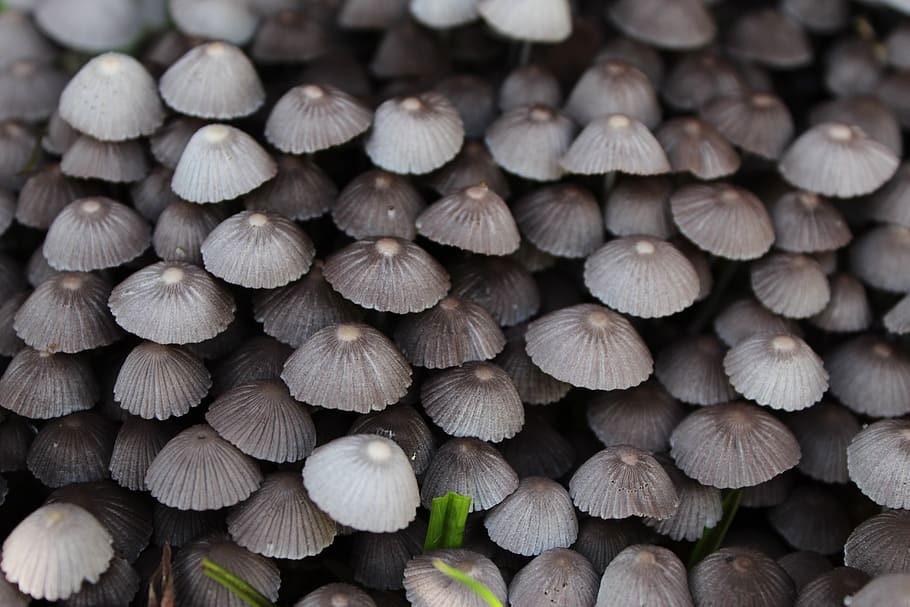
And anyway it turns out we’re not really individuals afterall…
Bernie Krause clip: https://www.youtube.com/watch?v=uWkMWDSVZuQ
Section 3: Armies of individuals
Microorganism, or microbe, is a microscopic organism, usually bacteria, virus or fungi.
*The Wizard and The Prophet
closeup, fungi - pxfuel.com
DNA is the material in the bodies of all known living organisms, and many viruses, that contains the genetic information to instruct the growth and functioning of the body. It is passed on from parent to child, and has long been thought to transfer information that is distinct and unchangeable, like eye-colour etc. DNA is found in cells in the body. Scott Gilbert writes that “it is depicted as that which is our essence and that which determines our behaviours, namely, our real selves” (2017, M76). The idea that everything about us is predetermined by the genetic information in our DNA, Gilbert writes, is used by several anti-abortion lobbyists. As your body makes new cells, DNA makes perfect copies of itself, a process called replication. It was discovered around 60 years ago. Anna Tsing writes that;
“At first glance the way DNA replicates within bodies, and is passed on from parent to child, seems to support this [individualist] worldview; the reproduction of species is self-contained, self-organised and unaffected by environmental encounters” (2015, 141).
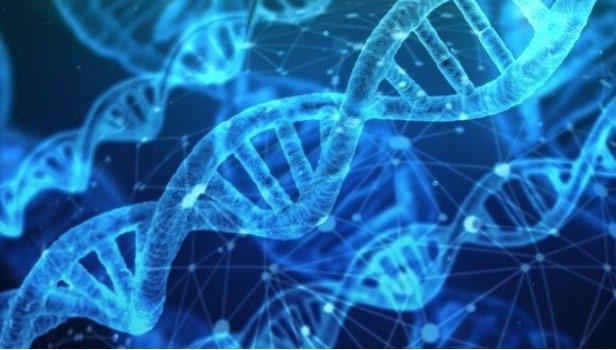
Section 4: transformed by encounter
However, in studying the development of DNA, researchers eventually “found themselves in conversation with ecologists… they found that many kinds of environmental effects could be passed on to offspring… one of their most surprising findings was that many organisms develop only through interactions with other species. A tiny hawaiian squid, Euprymna scolopes, has become the model for thinking about this process. The bob-tailed squid is known for its light organ, through which it mimics moonlight, hiding its shadow from predators. But juvenile squid do not develop this organ unless they come into contact with one particular species of bacteria, Vibrio fischeri. The squid are not born with these bacteria; they must encounter them in the seawater” (Tsing, A. 2015, 141-2).
There are other examples; a wasp who is unable to produce eggs without coming into contact with a particular type of bacteria, the larvae of the Large Blue Butterfly which will only survive if they’re taken in by an ant colony. And we humans are also transformed by encounter.
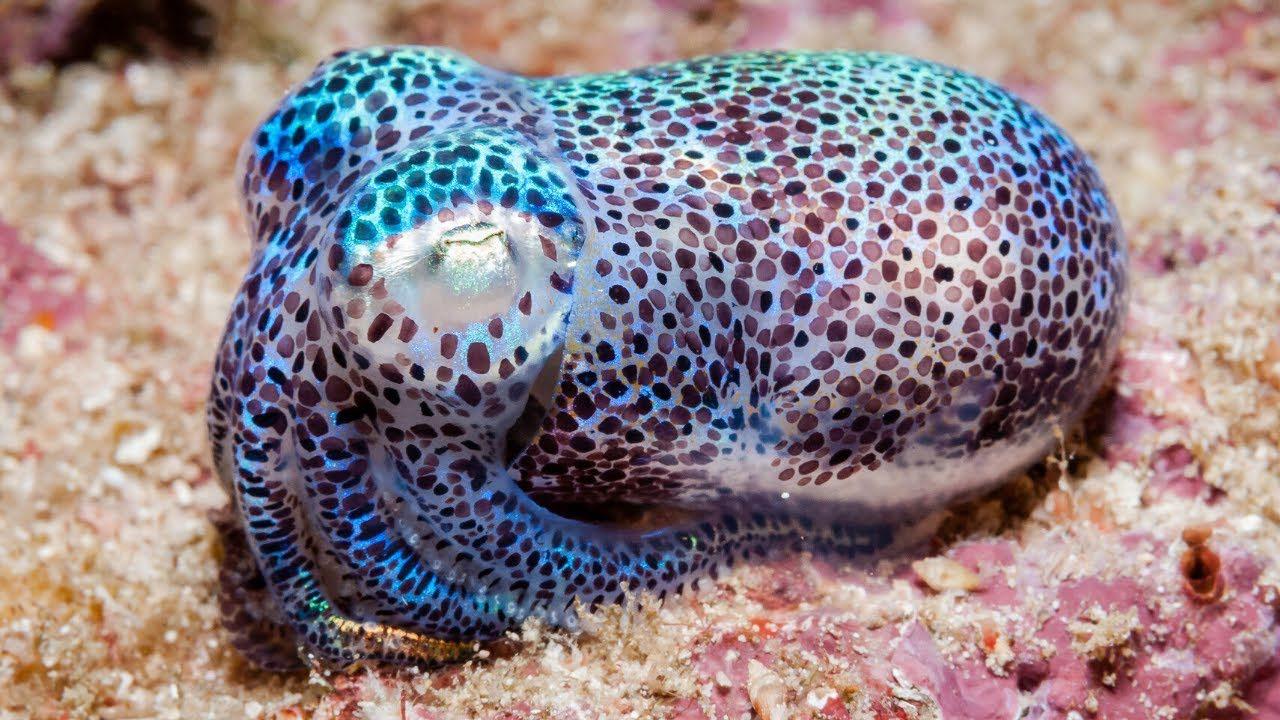
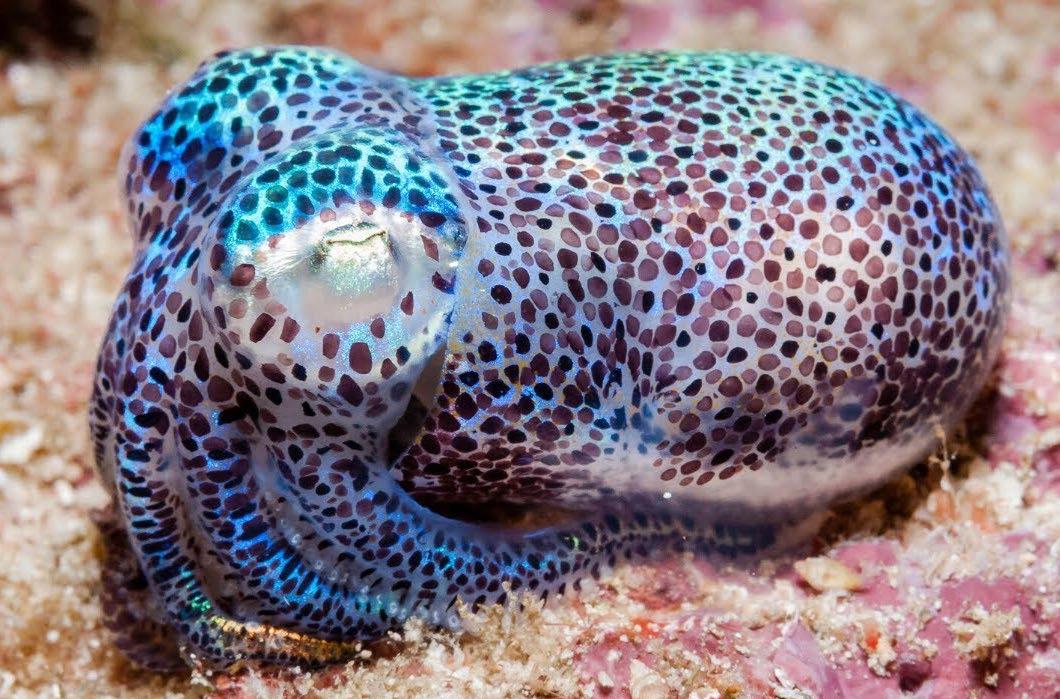
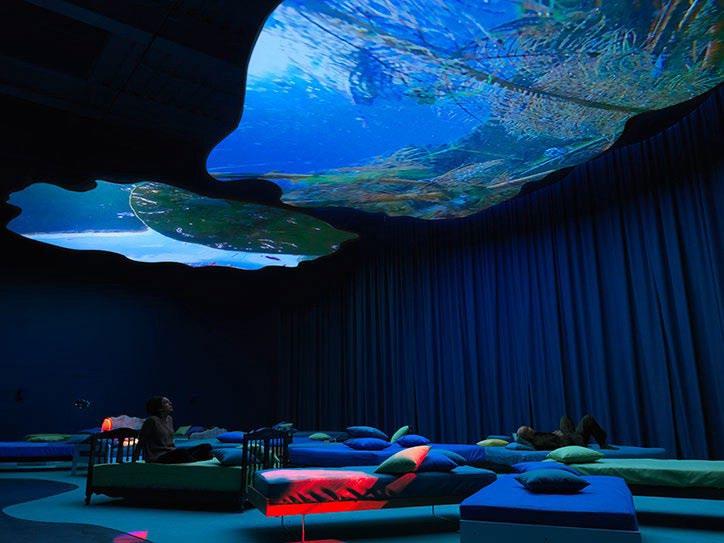
“Consider a phenomenon called microchimerism which occurs when cells from a fetus pass through the placenta and take up residence in the [parent’s] body, and vice versa… if you are a first born child, you will have a set of cells that come from your mother[/parent], including cells that she acquired from her own mother in the same way. If you are a youngest child, not only will you receive your mother’s cells, but you will also receive all of your siblings’ cells. We are thus not what we thought. Every “I” is also a “we”... our bodies are not only - not even primarily- composed of cells from our close kin. Indeed we are more microbe than human” (McFall-Ngai, M. M52, 2017).
“We proudly independent human beings are unable to digest our food without helpful bacteria, first gained as we slide out of the birth canal. 90% of the cells in the human body are bacteria.” (Tsing, A. 2015, 141-2).
Section 5: Being human? “Every I is also a we”
Cyborg is a term mostly used in Sci-fi to describe a figure who is part human, part machine. We use it in the spirit of Donna Haraway who used the term as a way to reject the rigid and essentialist boundaries between the individual, animal and machine.
‘At least 50% of human faeces is made up of bacteria shed from the gut’ caption & photo taken from BBC https://www.bbc.com/news/ health-37452630

“We have about 160 major species of bacteria in our bodies, and they all form complex ecosystems. Human bodies are and contain a plurality of ecosystems. Our mouths are different ecosystems than our intestines, or our skin, or our airways. The volume of the microbial organisms in our bodies is about the same as the volume of our brain… ” (Gilbert, S. M75, 2017)
The bacteria in a person’s digestive system change during pregnancy… “it appears that the hormones of the mother/[parent] are changing the bacteria so as to shape the bacterial population her/[their] baby acquires at birth… [in addition] a mother/[parent] has two sets of nutrients in her milk - one set for the newborn and one set for the for the bacteria that will help finish the construction of its gut capillaries and... tissues” (Gilbert, S. M81, 2017).
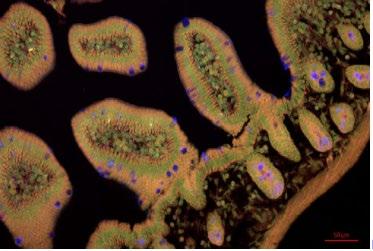
“Depression and anxiety have been linked to the presence or absence of certain microbes in the gut, they also regulate our sleep cycles, [which is why] taking antibiotics can disturb your sleep” (McFAll-Ngai, M. 2017, M64).
Even our DNA isn’t as human as we thought: “Human DNA is part virus; viral encounters mark historical moments in making us human” (Tsing, A. 2015, 143). And what’s more the amount of bacterial DNA in our bodies vastly outnumbers human DNA, “while we have about 22,000 different genes, the bacteria in us bring approximately 8 million more genes to the scene” (Gilbert, S. 2017, M76).
“It appears that there is no individuality in the classical biological sense” (Gilbert, S. 2017, M83).
Symbiosis is at play in huge eco-systems like forests and coral reefs. And within these symbiotic super organisms are smaller symbiotic organisms; our bodies, the bodies of plants and other living things, from microscopic to huge.
“Rather than competition, symbioses is the norm, and not the exception it was once thought to be… Nature may be selecting relationships rather than individuals” (Tsing, A. 2015, 141-2).
Very scientific recap: we are made of bacteria, viruses and our siblings. We are cyborgs!
bacteria in gut - source unknown - google image
But it’s not just that our bodies are shared with other living beings - they are produced by the labor of historical bodies. Thom Van Dooren asks us to understand species as “evolving ways of life that are shared, produced and nurtured in the world through the work of successive generations of living beings” (2014, 22).
As babies, we learn language by mimicking those around us; a process that carries through generations, ultimately linking us to our very earliest ancestors. Which begs the question, what did they mimic?
Bernie Krause, musician and sound ecologist, speculating about how early humans began to use language and sound:
“the sounds of animal life - organisms from microscopic to huge - and those from the non-biological landscape dominate the rather modest noises that [early] humans generate. They have limited language skills to express how they feel, but they borrow some from what they hear all around them to convey emotion” (Krause, B. 2012, 10)
Krause suggests that in music and speaking we are drawing on an ancient legacy of sound. Sounds of creatures long dead, and sounds of the earth itself were incorporated into ancient humans’ attempts to express themselves, passed down from generation to generation, undergoing a constant process of transformation. In every sound we make is the ghostly presence of extinct landscapes and their creatures.
The ever present ideology of individualism has made itself felt in Krause’s field of study too. In the history of soundscape/animal recording, Krause writes that, until recently, the focus was always on capturing the sound of individual animals; usually birds. Early on in his career as a soundscape recorder, Krause visited Kenya and there, trying to sleep in the ancient old growth forests, he noticed for the first time the deeply organised nature of the soundscape. Different animals vocalised at different timings and frequencies. What he had thought of as randomly emitted calls were revealed, in that ancient and relatively unharmed place, to be a carefully orchestrated composition, with
Section
6:
note on music
each animal/insect having its own acoustic niche - like the sections of an orchestra.
After returning home, he printed out the spectrograms of his recordingsspectrograms are visual representations of audio sequences, they look kind of similar to the imagery we associate with ultrasound. The spectrograms “plainly showed distinctive shapes not unlike modern forms of musical notation - the bat was vocalising in the highest frequency range, insects in the middle, the hyrax and hyenas a bit lower, and elephants down at the lowest end of the biophonic score” (Krause, B. 2012, 85). (Spectrogram: Bernie Krause).
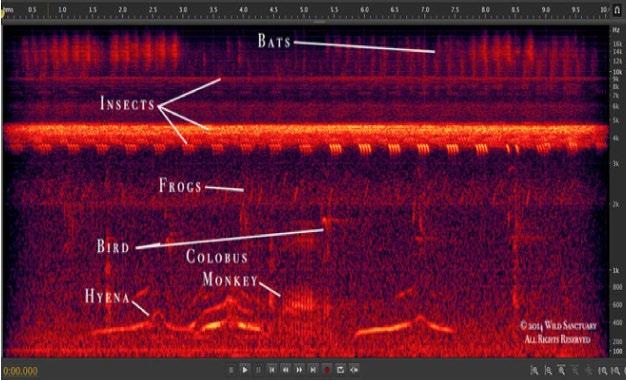
“Before I printed those first spectrograms on my return from Kenya, I had considered natural sound to be chaotic random expression. The reductionist single-species method we had all been taught had us coaxing each animal voice out of its coherent context and trying to derive meaning from the sounds we abstracted from the natural world.” (Krause, B. 2012, 86).
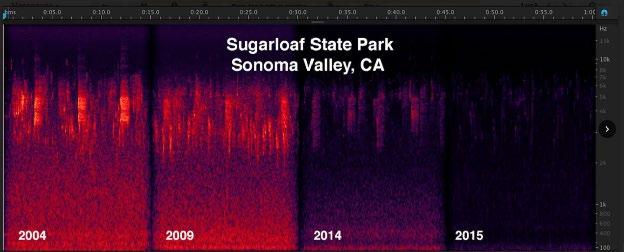
(A place falling quiet due to logging)
The planet itself teems with a vigorous resonance that is as complete and expansive as it delicately balanced. Every place, with its vast populations of plants and animals, becomes a concert hall, and everywhere a unique orchestra performs an unmatched symphony, with each species’ sound fitting into a specific score. It is a highly evolved, naturally wrought masterpiece” (Krause, B. 2012, 10).
Candice Lin, 5 Kingdoms
Image description: plants, fungi, animals, and protists radiating from bacteria
Candice Lin, “You are a spacious fluid sac,” installation view at Francois Ghebaly Gallery. (Robert Wedemeyer) https://www.latimes. com/entertainment/arts/ la-et-cm-candice-lin-atfrancois-ghebaly-gallery20151012-story.html
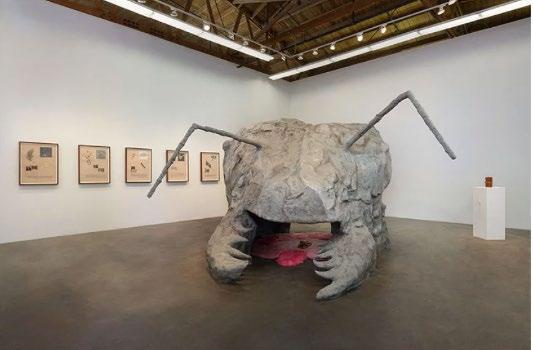
Section 7: Losing things again
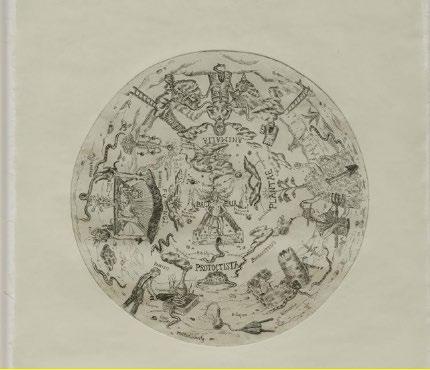
In this understanding of life, extinction becomes an even greater phenomenon than we might have previously thought. Margaret McFall-Ngai reminds us that when “a larger organism disappears, its suite of coevolved microbes disappear too” (M66, 2017).
“What does it mean that, in this time of incredible loss, there is so little public (and perhaps also private) mourning for extinctions?
At the core of the answer that I would like to propose to these questions is our inability to get - to really comprehend at any meaningful level - the multiple connections and dependencies between ourselves and these disappearing others: failure to appreciate all the ways in which we are at stake in one another, all the ways in which we share a world. This failure is, at least in part, rooted in … human exceptionalism.” (Van Dooren, T. 2014, 140)
“When we hyperseparate ourselves from nature and reduce it conceptually, we not only lose the ability to empathise and to see the non-human sphere in ethical terms, but also get a false sense of our own character and location that includes an illusory sense of agency and autonomy.” (Plumwood, V. qtd,2014, 141).
Cover art for Proto. A mashup of the faces of everyone who contributed to the album.
Section 8: Extreme Love and musical cyborgs
The music this week is by Holly Herndon. Both lyrically and formally it expresses a lot of what we’ve been talking about today. The songs Extreme Love and Frontier are taken from an album called Proto, which features a chorus of singers collaborating with Spawn - Holly Herndon’s AI “baby”... “Trained to process audio, Spawn uses neural networks to riff on music she hears; Herndon, who uses she/her pronouns to refer to Spawn, considers the AI not as an instrument or a tool but as an ensemble member.”
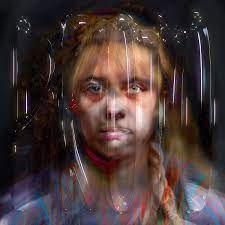
“Voice processors have proliferated since the 1970s, and in many of their most notable uses they have shredded, distorted, and multiplied the voices of women. In the 1980s, Laurie Anderson deployed a series of digital filters oriented toward comically deepened “vocal drag,” which also served as her own trio of backup singers. In 1998, Cher’s “Believe” threw Auto-Tune technology into overdrive to force her voice into a futuristic trill. This century’s musical cyborgs are some of the most fascinating and innovative contemporary performers: FKA twigs, Fever Ray, Charli XCX, SPELLLING, Arca, SOPHIE. That none of these artists are men points to a gender-transgressive impulse within cyborg performance: a desire to use technology to break open the body’s perceived boundaries and take flight away from the repressive and the mundane.
“The popular image of a cyborg is one of body augmentation,” Herndon said in a 2015 interview, whereas she and her collaborator Mat Dryhurst are “more interested in the emotional cyborg—those who use tools to emote, express compassion, build alliances across networks, disperse into anonymity.”” (Sasha Geffen reviewing Proto in Pitchfork: https:// pitchfork.com/reviews/albums/holly-herndon-proto/) https://open.spotify.com/playlist/1z3BgHHVB32dX3h-
1Geg04i?si=103e1337e1594c09
Discussion point:

























